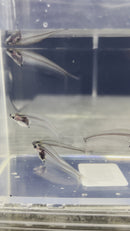Description
The Glass Catfish, scientifically known as Kryptopterus vitreolus, is a fascinating and visually striking freshwater fish species known for its transparent appearance and graceful swimming. This unique and captivating fish is a favorite among aquarium enthusiasts, adding a touch of elegance and intrigue to any aquatic setup. Here's a detailed description of the Glass Catfish:
Appearance: The most remarkable feature of the Glass Catfish is its translucent body, which allows you to see through its skin, revealing its internal organs and skeletal structure. This transparent quality earned it the name "Glass Catfish." Their body is elongated and slender, with a slightly flattened belly. Their head is characterized by a bony plate, and their dorsal fin extends along the length of their body. Glass Catfish lack prominent scales, which further enhances their see-through appearance.
Despite their transparency, you can observe a faint silver or pale white coloration in their flesh, providing a subtle contrast that highlights their internal structures. These fish typically reach a length of about 3 to 4 inches (7.5 to 10 centimeters).
Behavior: Glass Catfish are known for their calm and peaceful nature, making them excellent candidates for community aquariums. They are typically found in groups, and they exhibit shoaling behavior, so keeping them in small schools of five or more individuals is advisable. When they swim together, their synchronized movements create a mesmerizing spectacle, adding beauty and interest to the tank.
Habitat and Care: To create an ideal habitat for Glass Catfish, replicate their natural environment in the aquarium. They originate from slow-moving, clear freshwater rivers and streams in Southeast Asia, so provide a well-planted tank with plenty of open swimming space. These fish appreciate hiding spots in the form of driftwood, caves, or dense vegetation. Maintain water temperature in the range of 72°F to 78°F (22°C to 26°C) and a slightly acidic to neutral pH level (6.5 to 7.5). Ensure good water quality through proper filtration and regular water changes.
Diet: Glass Catfish are omnivorous and readily accept a variety of foods. They primarily feed on small invertebrates, worms, and tiny crustaceans in the wild. In captivity, they can be fed a diet of high-quality flake food, pellets, live or frozen foods like bloodworms, brine shrimp, and daphnia. Offering a balanced diet ensures their health and longevity.
Payment & Security
Your payment information is processed securely. We do not store credit card details nor have access to your credit card information.



